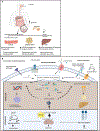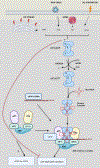The crosstalk between metabolism and translation
- PMID: 39232280
- PMCID: PMC11586076
- DOI: 10.1016/j.cmet.2024.07.022
The crosstalk between metabolism and translation
Abstract
Metabolism and mRNA translation represent critical steps involved in modulating gene expression and cellular physiology. Being the most energy-consuming process in the cell, mRNA translation is strictly linked to cellular metabolism and in synchrony with it. Indeed, several mRNAs for metabolic pathways are regulated at the translational level, resulting in translation being a coordinator of metabolism. On the other hand, there is a growing appreciation for how metabolism impacts several aspects of RNA biology. For example, metabolic pathways and metabolites directly control the selectivity and efficiency of the translational machinery, as well as post-transcriptional modifications of RNA to fine-tune protein synthesis. Consistently, alterations in the intricate interplay between translational control and cellular metabolism have emerged as a critical axis underlying human diseases. A better understanding of such events will foresee innovative therapeutic strategies in human disease states.
Keywords: disease; mRNA translation; metabolism; protein synthesis; signaling.
Copyright © 2024 Elsevier Inc. All rights reserved.
Conflict of interest statement
Declaration of interests D.R. is a shareholder of eFFECTOR Therapeutics, Inc. and a member of its scientific advisory board.
Figures





References
-
- Ghaben AL & Scherer PE Adipogenesis and metabolic health. Nature reviews Molecular cell biology 20, 242–258 (2019). - PubMed
-
- Schiaffino S, Dyar KA, Ciciliot S, Blaauw B & Sandri M Mechanisms regulating skeletal muscle growth and atrophy. The FEBS journal 280, 4294–4314 (2013). - PubMed
-
- Kaur J & Debnath J Autophagy at the crossroads of catabolism and anabolism. Nature reviews Molecular cell biology 16, 461–472 (2015). - PubMed
Publication types
MeSH terms
Substances
Grants and funding
LinkOut - more resources
Full Text Sources

